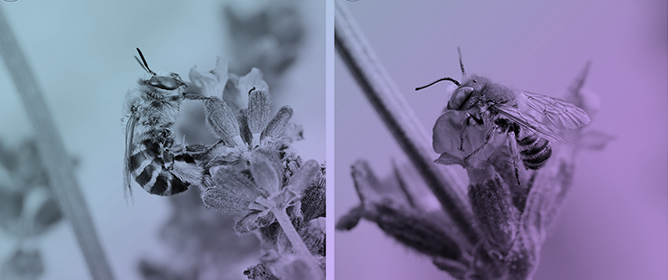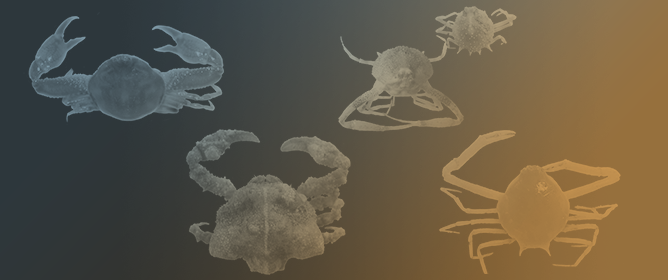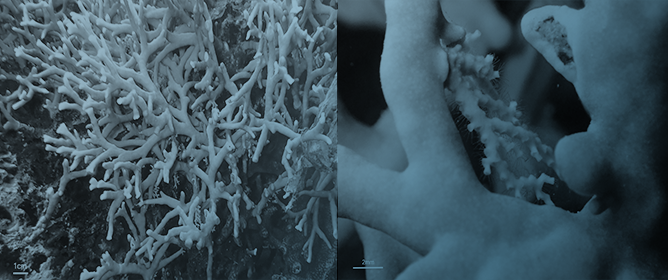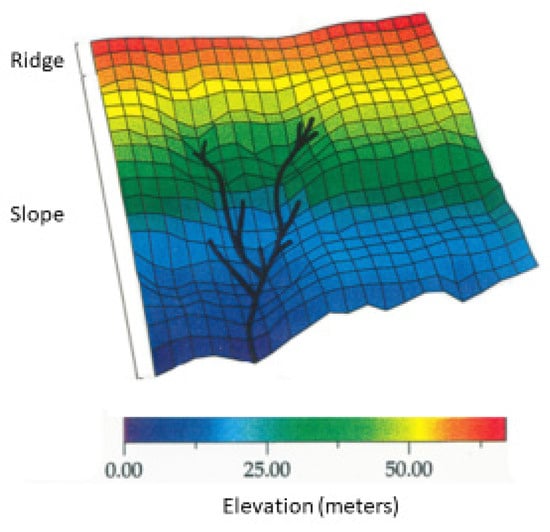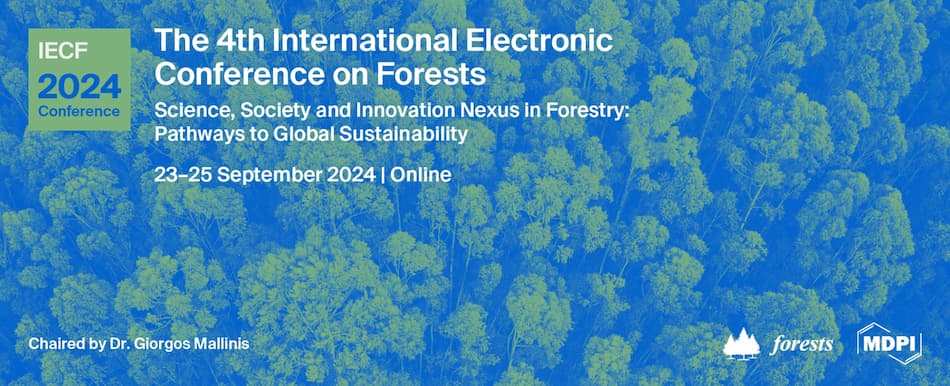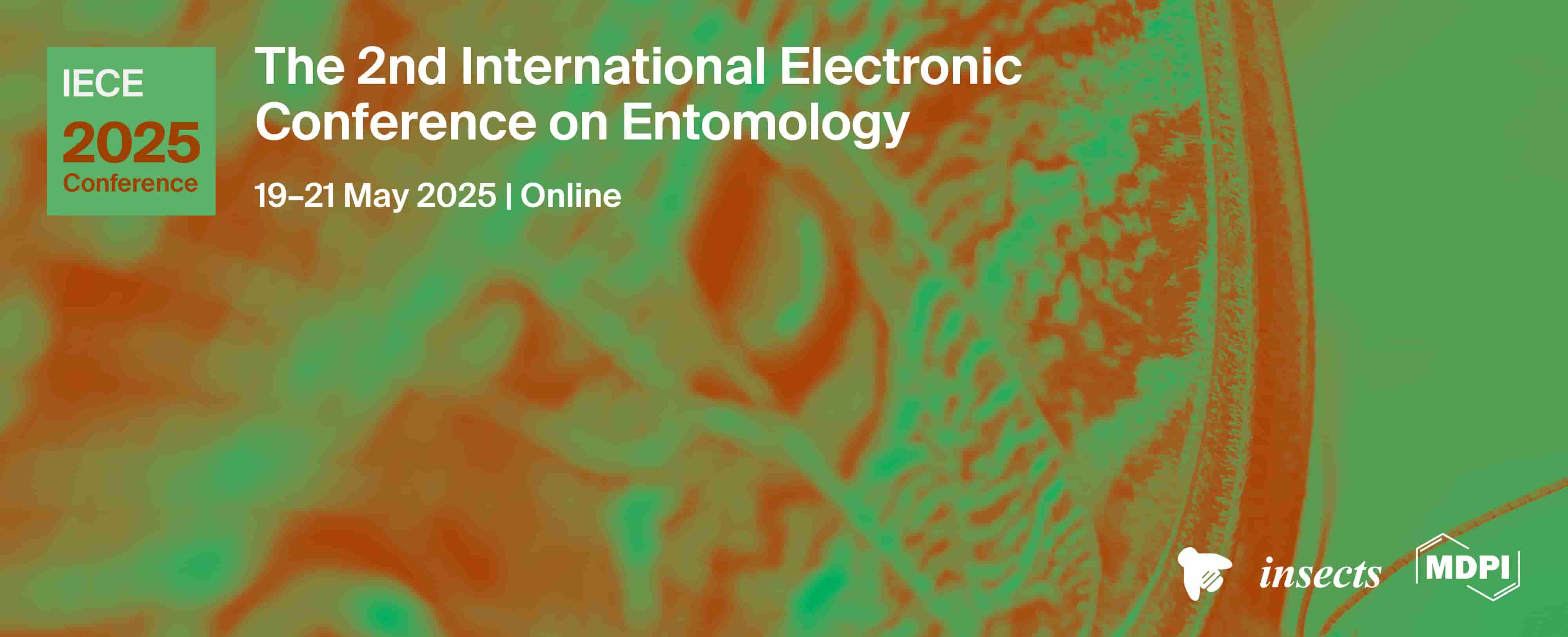Journal Description
Diversity
Diversity
is a peer-reviewed, open access journal on the science of biodiversity from molecules, genes, populations, and species, to ecosystems and is published monthly online by MDPI.
- Open Access— free for readers, with article processing charges (APC) paid by authors or their institutions.
- High Visibility: indexed within Scopus, SCIE (Web of Science), PubAg, GEOBASE, CAPlus / SciFinder, and other databases.
- Journal Rank: JCR - Q2 (Biodiversity Conservation) / CiteScore - Q2 (Agricultural and Biological Sciences (miscellaneous))
- Rapid Publication: manuscripts are peer-reviewed and a first decision is provided to authors approximately 17.8 days after submission; acceptance to publication is undertaken in 2.8 days (median values for papers published in this journal in the second half of 2023).
- Recognition of Reviewers: reviewers who provide timely, thorough peer-review reports receive vouchers entitling them to a discount on the APC of their next publication in any MDPI journal, in appreciation of the work done.
Impact Factor:
2.4 (2022);
5-Year Impact Factor:
2.5 (2022)
Latest Articles
Species Composition and Distribution of Terrestrial Herbs in a High Montane Forest in Ecuador
Diversity 2024, 16(5), 262; https://doi.org/10.3390/d16050262 (registering DOI) - 27 Apr 2024
Abstract
In mountain tropical forests, understory herbs have received little attention compared to trees, and their commonness and rarity are virtually unknown. We studied ground herbs to explore how they are assembled in a full one-hectare plot and to test the influence of light
[...] Read more.
In mountain tropical forests, understory herbs have received little attention compared to trees, and their commonness and rarity are virtually unknown. We studied ground herbs to explore how they are assembled in a full one-hectare plot and to test the influence of light intensity (LI) and topographic habitats in species composition. The plot is a humid montane forest located in the Pasochoa Volcano, at 3300 m. We found 43 genera and 50 perennial species (30 angiosperms in 17 families, and 20 ferns). Interestingly, herbs are 64% richer in species than trees in the same study plot (50 vs. 32). Herbs were mostly obligately terrestrial (70% of the species), while 30% were fallen climbers and epiphytes rooted in the ground. Across the forest, there were 31,119 individuals that covered 8.5% of the ground. We concluded that both LI and topography shaped the species distribution, the floristic composition, and the community structure of ground herbs. For instance, 12% of the species were exclusively found in places with high LI; the rest of species grew in medium- to low-LI environments. Concerning rarity, we found that 39% of the species are rare (judging by botanical collections; <100), which stresses the need of conservation strategies for this group of plants.
Full article
(This article belongs to the Special Issue Diversity Hotspots)
►
Show Figures
Open AccessArticle
The Mosquitoes of Morelos, Mexico: DNA Barcodes, Distribution, Ecology and the Resurrection of the Name Culiseta dugesi Dyar and Knab (Diptera: Culicidae)
by
Aldo I. Ortega-Morales, Luis M. Hernández-Triana, Javier A. Garza-Hernández, Carlos M. Ramírez-Huicochea, Andrés J. Martínez-Gaona, J. Manuel Quijano-Barraza, Cassandra González-Acosta and Fabián Correa-Morales
Diversity 2024, 16(5), 261; https://doi.org/10.3390/d16050261 - 26 Apr 2024
Abstract
To update the record of mosquito diversity in the state of Morelos, Mexico, mosquito collections were conducted in both physiographical regions of Morelos: the Neo-volcanic Axis and the South Mountain Range. Immature stages were collected from aquatic habitats, while adult mosquitoes were collected
[...] Read more.
To update the record of mosquito diversity in the state of Morelos, Mexico, mosquito collections were conducted in both physiographical regions of Morelos: the Neo-volcanic Axis and the South Mountain Range. Immature stages were collected from aquatic habitats, while adult mosquitoes were collected using CDC light traps, Shannon traps and approaching/landing on the collecting personnel. All specimens were identified using taxonomic keys and the mitochondrial cytochrome C oxidase subunit 1 (COI). Following Mexico State, this is the second study of mosquito taxonomy of a complete Mexican state using COI barcoding. In Morelos, a total of 58 species of mosquito occurs, of which we report 12 for first time (Aedes vexans, Ae. euplocamus, Ae. vargasi, Psorophora cilipes, Ps. lineata, Culex restrictor, Cx. interrogator, Cx. nigripalpus, Cx. tarsalis, Cx. sandrae, Cx. lactator and Toxorhynchites moctezuma). Morelos now ranks sixth in mosquito diversity among Mexican states. Phylogenetic trees were constructed for 32 species, including Ae. shannoni, which is a new record for GenBank databases. Additionally, we report COI barcode sequences of Culiseta dugesi Dyar and Knab, which is resurrected from the synonymy of Cs. particeps (Adams). Fourth-instar larvae and adult females of Cs. dugesi were redescribed. This brings the number of mosquito species in Mexico to 248. Ecological and distributional notes for the new records, the medical importance of mosquito species in Morelos, and an identification key for larvae and females of the known Culiseta species occurring in Mexico are also included.
Full article
(This article belongs to the Special Issue Diptera in Aquatic and Semiaquatic Environments: Diversity and Adaptations)
►▼
Show Figures
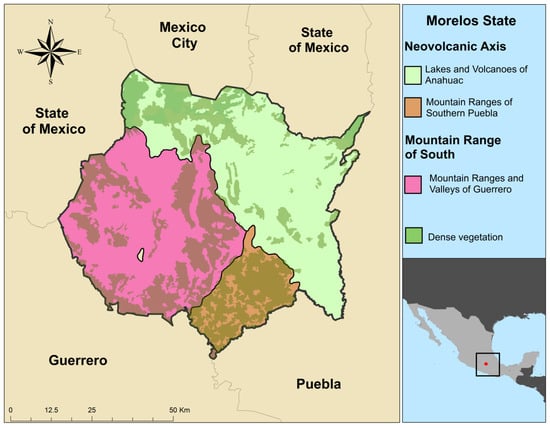
Figure 1
Open AccessArticle
Biodiversity Conservation in Xishuangbanna, China: Diversity Analysis of Traditional Knowledge Related to Biodiversity and Conservation Progress and Achievement Evaluation
by
Qing Huang, Yinzhi Kuang, Hao Zhou, Xunqi Li and Lun Yin
Diversity 2024, 16(5), 260; https://doi.org/10.3390/d16050260 - 26 Apr 2024
Abstract
Biodiversity plays an important role in maintaining the ecological balance of the earth. The study of traditional knowledge related to biological resources is a hot issue in the field of international biodiversity conservation. Xishuangbanna is a key area of biodiversity and a cultural
[...] Read more.
Biodiversity plays an important role in maintaining the ecological balance of the earth. The study of traditional knowledge related to biological resources is a hot issue in the field of international biodiversity conservation. Xishuangbanna is a key area of biodiversity and a cultural hotspot of international significance. According to the Technical Regulation for Classification, Investigation, and Inventory of Traditional Knowledge Relating to Biological Diversity issued by the Ministry of Ecology and Environment, we investigated and catalogued the traditional knowledge related to biodiversity of the Jino people who have lived in Xishuangbanna for generations, and collected 490 entries of traditional knowledge related to biodiversity of the Jino people. Drawing on the traditional knowledge diversity index calculation method proposed by Wang Guoping, the overall traditional knowledge α-diversity index of the Jino people is 0.63, indicating that the richness of the traditional knowledge of the Jinuo people is relatively high. The traditional culture related to biodiversity, the traditional knowledge related to agricultural genetic resources, and the traditional technology related to the sustainable utilization of biological resources are relatively rich and diverse. The diversity index is 0.86, 0.82 and 0.79, respectively. In addition, Xishuangbanna has invested a lot of energy in biodiversity protection, including the establishment of nature reserves, botanical gardens, zoos, ecological tea gardens and other species reserves, and the promulgation of laws and policies related to biodiversity protection, and has achieved remarkable results in in situ protection and ex situ protection. On the basis of analyzing the progress and achievements of biodiversity conservation in Xishuangbanna, this study points out that Xishuangbanna faces challenges such as the loss of traditional knowledge, insufficient conservation efforts, and great changes in land use, and puts forward corresponding suggestions.
Full article
(This article belongs to the Special Issue Biodiversity Conservation Planning and Assessment)
►▼
Show Figures

Figure 1
Open AccessReview
Understanding the Distribution, Behavioural Ecology, and Conservation Status of Asian Pelophylax
by
Hina Amin and Amaël Borzée
Diversity 2024, 16(5), 259; https://doi.org/10.3390/d16050259 - 25 Apr 2024
Abstract
Understanding species from an ecological and phylogenetic perspective facilitates an understanding of their conservation status in relation to the changing world. The frog genus Pelophylax is among the largest in terms of amphibian biomass in the Palearctic, but species have not been thoroughly
[...] Read more.
Understanding species from an ecological and phylogenetic perspective facilitates an understanding of their conservation status in relation to the changing world. The frog genus Pelophylax is among the largest in terms of amphibian biomass in the Palearctic, but species have not been thoroughly studied at the Asian continental scale. The phylogeographic relationship, behavioural ecology, and ecological requirements within the genus need clarification, despite generally good local coverage. Here, for the first time, we conducted a literature review focused on phylogeography and behavioural ecology, supported by ecological niche modelling of twelve Asian Pelophylax lineages. Finally, we compiled the known threats for each of the lineages. We first determined the presence of twelve species and species-candidate lineages. In terms of behavioural ecology, the main difference among lineages is the time to metamorphosis and the time to reach sexual maturity. The ecological models highlighted a match between the known presence of each clade and their suitable habitat and highlighted the Syr Darya drainage on the eastern shore of the Caspian Sea for the non-described Pelophylax “Syr Darya lineage”. Finally, we highlighted the greatest variation among lineages in terms of threats, as some lineages are threatened by numerous factors, whereas others are expanding.
Full article
(This article belongs to the Special Issue Feature Papers on Ectotherms in a Dynamic Environment: Understanding Patterns of Ecology, Distribution, Evolution, and Threats to Species)
►▼
Show Figures
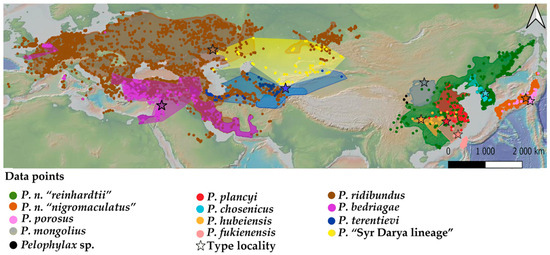
Figure 1
Open AccessArticle
Too Warm and Too Dry—Decline and Threat of the Subarctic-Subalpine Liverwort Hygrobiella laxifolia in a Low Mountain Range in Central Europe under the Conditions of Climate Change
by
Frank Müller, Ivana Marková and Christiane M. Ritz
Diversity 2024, 16(5), 258; https://doi.org/10.3390/d16050258 - 24 Apr 2024
Abstract
Using the liverwort Hygrobiella laxiflora as an example, this study aims to investigate the impact of climate change on montane species and their ecosystems. The study area is the Elbe Sandstone Mountains in Germany and the Czech Republic, where Hygrobiella laxifolia has an
[...] Read more.
Using the liverwort Hygrobiella laxiflora as an example, this study aims to investigate the impact of climate change on montane species and their ecosystems. The study area is the Elbe Sandstone Mountains in Germany and the Czech Republic, where Hygrobiella laxifolia has an isolated occurrence in deeply carved gorges characterized by a specific microclimate (cellar climate). The focus is on determining the rate at which populations are affected. After little change in the population over a long period, a sudden sharp decline has been observed in recent years. The decline correlates with the mass proliferation of the European spruce bark beetle (Ips typographus) observed since 2017, which has led to a strong thinning of the forests in the area. In many areas of occurrence, the forests now have a much sparser tree layer or none at all. Competition from other, more competitive species also plays an important role as a cause of decline, as these have spread more widely on the sites due to the now higher light levels. The severe bark beetle infestation and the large-scale forest fire of 2022 both represent events that led to the almost complete deforestation of large parts of the study area, which was previously unknown on this scale. Since both the bark beetle infestation and the forest fire are strongly intensified by climate change, we assume that climate change is the main reason for the decline of Hygrobiella laxifolia in the area. The populations of Hygrobiella laxifolia of the Elbe Sandstone Mountains show some morphological peculiarities. As two new species have recently been described within Hygrobiella, we have integrated a sample from the area into a molecular phylogeny of Hygrobiella based on the plastid sequences of trnL-trnF intergenic spacer and matK to clarify the relationships. The sample from Elbe Sandstone Mountains fits well into the clade of Hygrobiella laxifolia.
Full article
(This article belongs to the Special Issue Distribution of Bryophytes in a Changing World)
►▼
Show Figures
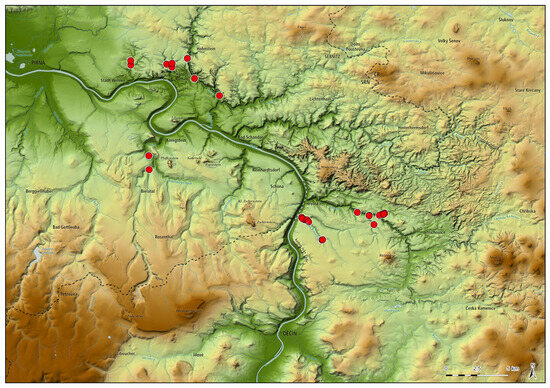
Figure 1
Open AccessArticle
Towards a Comprehensive DNA Barcode Library of Stenochironomus Kieffer, 1919 (Diptera: Chironomidae) from China
by
Hui Wang, Hai-Feng Xu, Chen-Hong Li, Hai-Xin Zhang, Yan-Ping Zhang, Bing-Jiao Sun and Xiao-Long Lin
Diversity 2024, 16(5), 257; https://doi.org/10.3390/d16050257 - 24 Apr 2024
Abstract
The adoption of DNA-based assessments for biodiversity monitoring has been on the rise. However, the effectiveness of DNA-based taxonomic assignments heavily relies on the availability and reliability of DNA barcode libraries. There is growing demand for a comprehensive understanding of aquatic biodiversity and
[...] Read more.
The adoption of DNA-based assessments for biodiversity monitoring has been on the rise. However, the effectiveness of DNA-based taxonomic assignments heavily relies on the availability and reliability of DNA barcode libraries. There is growing demand for a comprehensive understanding of aquatic biodiversity and the critical role of Chironomidae, specifically Stenochironomus in freshwater ecosystems. Therefore, our objective is to develop a reference barcode library for Stenochironomus in China. From 2016 to 2021, we collected Stenochironomus specimens in diverse Chinese landscapes using malaise traps, light traps, and sweep nets. These specimens were carefully preserved for DNA extraction and barcode sequencing. Our analysis unveiled 36 unique operational taxonomic units from 180 COI barcode sequences through a Neighbor-Joining tree and Automatic Barcode Gap Discovery program, highlighting a significant diversity within the Stenochironomus species. The findings emphasize the constraints of conventional morphological identification methods, especially for species with ambiguous morphologies. It also underscores the effectiveness of DNA barcoding in revealing hidden species diversity, known as cryptic species. Consequently, this study advocates for an integrated taxonomic approach, combining morphological and molecular data, to refine species identification and conservation strategies.
Full article
(This article belongs to the Special Issue Freshwater Zoobenthos Biodiversity, Evolution and Ecology)
►▼
Show Figures

Figure 1
Open AccessBrief Report
An Initial Survey of Unionid Mussels in Lakes East of the Missouri River in South Dakota, USA
by
Riley E. Henderson, Katherine M. Wollman, Chelsey A. Pasbrig and Michael E. Barnes
Diversity 2024, 16(5), 256; https://doi.org/10.3390/d16050256 - 24 Apr 2024
Abstract
This study surveyed freshwater mussels (family Unionidae) in 116 lakes and reservoirs east of the Missouri River in South Dakota, USA, during 2017. Using two-person–hour/site timed searches, evidence of a total of 1789 mussels, including 1053 live mussels, was obtained from 50 waters.
[...] Read more.
This study surveyed freshwater mussels (family Unionidae) in 116 lakes and reservoirs east of the Missouri River in South Dakota, USA, during 2017. Using two-person–hour/site timed searches, evidence of a total of 1789 mussels, including 1053 live mussels, was obtained from 50 waters. Nine species, from two different orders, were found in lakes and reservoirs throughout five of the six major river drainages east of the Missouri River. The native species observed included Giant Floater Pyganodon grandis, Fatmucket Lampsilis siliquoidea, Threeridge Amblema plicata, White Heelsplitter Lasmigona complanata, Wabash Pigtoe Fusconaia flava, Deertoe Truncilla truncata, and Pink Heelsplitter Potamilus alatus. Giant Floater was the most widespread and abundant species observed, representing 63.3% of the live mussels sampled. Two non-native species, Zebra Mussel Dreissena polymorpha and Chinese Basket Clam Corbicula fluminea, were also documented from three water bodies in the lower Missouri River drainage. Overall, mussel abundance was negatively correlated with lake water conductivity and positively correlated with turbidity. No significant correlations were observed between species abundance and water temperature, pH, dissolved oxygen, or substrate particle size.
Full article
(This article belongs to the Special Issue Population Ecology and Protection of Freshwater Mussels)
►▼
Show Figures
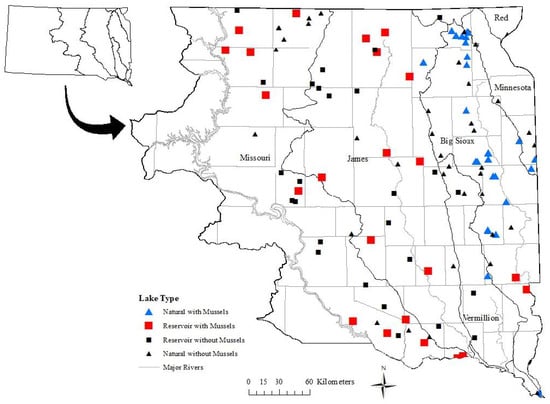
Figure 1
Open AccessArticle
Evaluation of Pesticides on Detritus-Inhabiting and Root-Associated Fungi in Aquatic Habitats and Potential Implications
by
Daniel B. Raudabaugh, Andrew N. Miller and Claudia K. Gunsch
Diversity 2024, 16(5), 255; https://doi.org/10.3390/d16050255 - 24 Apr 2024
Abstract
Pesticide contamination of aquatic ecosystems poses a significant threat to humans and can adversely affect fungal-driven processes in these understudied habitats. Here, we investigated the effects of four pesticides on detritus-inhabiting and plant root-associated fungi from streams, peatlands, and saltwater marshes. Additionally, we
[...] Read more.
Pesticide contamination of aquatic ecosystems poses a significant threat to humans and can adversely affect fungal-driven processes in these understudied habitats. Here, we investigated the effects of four pesticides on detritus-inhabiting and plant root-associated fungi from streams, peatlands, and saltwater marshes. Additionally, we assessed the isolates’ capacities to degrade three carbon sources to understand the impact of pesticides on fungal-driven processes. Pesticide assays were conducted in 96-well glass-coated plates, with fungal growth measured using a UV-Vis spectrophotometer set to 595 nm. Assays included technical replication (n = 6), replication over time (n = 2), negative controls, and carry-over controls. In total, we assayed more than 153 isolates, representing up to 97 fungal genera. Results showed that 1.9%, 49.7%, 3.1%, and 5.6% of the isolates exhibited consistently lower growth when exposed to atrazine, mancozeb, cypermethrin, and malathion, respectively. Furthermore, 101 isolates, comprising 87 genera, were tested for cellulase, starch degradation, and tannase activity, with 41.6%, 28.7%, and 30.7% of the isolates testing positive, respectively. These findings suggest that while many species demonstrate functional redundancy, some fungal species are sensitive to current environmental pesticide levels, which affects their growth and may have broader implications on ecosystem health.
Full article
(This article belongs to the Special Issue Fungi, Ecology, and Global Change)
►▼
Show Figures
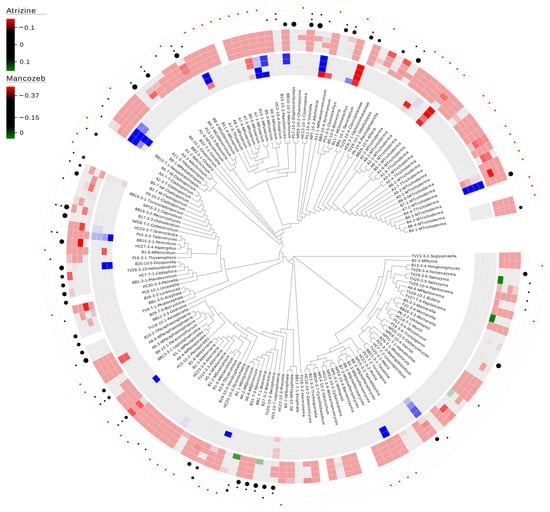
Figure 1
Open AccessArticle
The Lichen Genus Letrouitia (Brigantiaeaceae, Ascomycota) in China
by
Can Cui, Mingzhu Dou, Shuhao Jiang and Zefeng Jia
Diversity 2024, 16(5), 254; https://doi.org/10.3390/d16050254 - 23 Apr 2024
Abstract
Based on morphological, chemical and molecular studies, two new species of the lichen genus Letrouitia are newly described from China. Letrouitia arcuata is distinguished by its arcuate ascospores [8–10(–12)-locular, (28–)33–50(–62.5) × (8–)10–14.5 µm] and L. sinuosa by its ascomata with wavy margins and
[...] Read more.
Based on morphological, chemical and molecular studies, two new species of the lichen genus Letrouitia are newly described from China. Letrouitia arcuata is distinguished by its arcuate ascospores [8–10(–12)-locular, (28–)33–50(–62.5) × (8–)10–14.5 µm] and L. sinuosa by its ascomata with wavy margins and ascospores with lens-shaped locules [6–8-locular, (18–)19.5–32(–34) × (6.5–)8–14 μm]. In addition, L. magenta is reported for the first time as a new record in China, characterized by small and round ascomata. The descriptions, distribution and phylogenetic analysis of the respective species have been actualized and a key to the Letrouitia species known from China is provided.
Full article
(This article belongs to the Special Issue Phylogeny, Taxonomy and Ecosystems of Lichens)
►▼
Show Figures
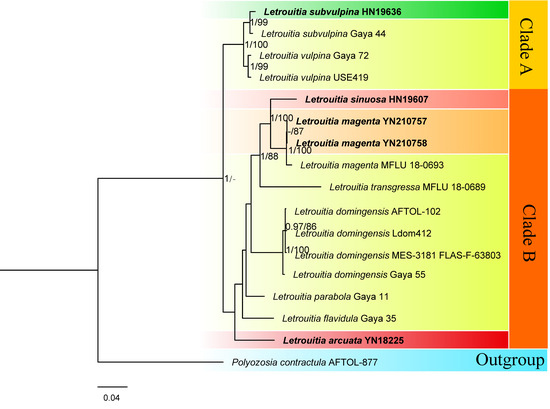
Figure 1
Open AccessInteresting Images
Threats to a Temperate Kelp Forest Species, Ecklonia cava, through Tropical Fish Herbivory Associated with Sea Surface Warming in the East China Sea
by
Sun Kyeong Choi, Taihun Kim, Young Baek Son and Sang Rul Park
Diversity 2024, 16(5), 253; https://doi.org/10.3390/d16050253 - 23 Apr 2024
Abstract
Kelp forests in Korean waters, mainly consisting of Ecklonia cava, provide ecologically and economically important ecosystems. However, they are severely threatened by increasing sea surface temperature (SST). In 2023, an unusually high SST was observed in the northern East China Sea, where
[...] Read more.
Kelp forests in Korean waters, mainly consisting of Ecklonia cava, provide ecologically and economically important ecosystems. However, they are severely threatened by increasing sea surface temperature (SST). In 2023, an unusually high SST was observed in the northern East China Sea, where the average SST from August to November 2023 was found to be 1.1 °C higher than the average SST during the same period over the last two decades. Our photo images and videos reveal increasing feeding on E. cava populations by tropical herbivore rabbitfish (Siganus canaliculatus, Siganus fuscescens) associated with the impact of increasing SST. Given the fall reproductive peak of E. cava population, increased herbivory by tropical rabbitfish could have a significant adverse impact on the composition of temperate kelp forests.
Full article
(This article belongs to the Collection Interesting Images from the Sea)
►▼
Show Figures
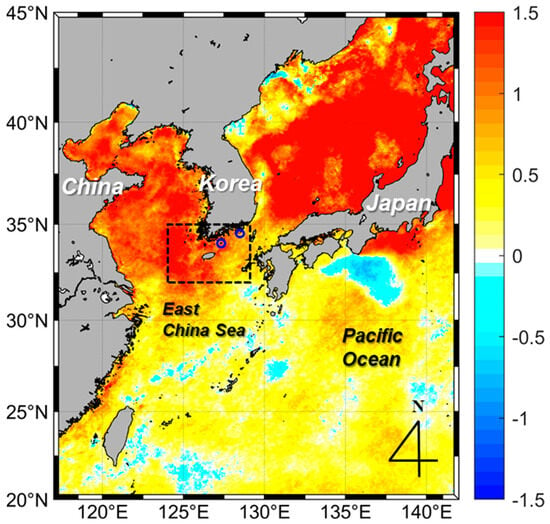
Figure 1
Open AccessArticle
Associations between Epiphytic Orchids and Their Hosts and Future Perspectives of These in the Context of Global Warming
by
Binu Timsina, Zuzana Münzbergová, Pavel Kindlmann, Bishnu Prasad Bhattarai, Bikram Shrestha, Bhakta B. Raskoti and Maan B. Rokaya
Diversity 2024, 16(4), 252; https://doi.org/10.3390/d16040252 - 22 Apr 2024
Abstract
Epiphytic species are ecologically important and a significant component of biodiversity. To ensure their efficient conservation, we need to understand their ecology and host plant associations. It is also important to investigate how the predicted temperature change will affect their future distribution. Here,
[...] Read more.
Epiphytic species are ecologically important and a significant component of biodiversity. To ensure their efficient conservation, we need to understand their ecology and host plant associations. It is also important to investigate how the predicted temperature change will affect their future distribution. Here, we use data collected in Nepal to investigate how epiphytic orchids are associated with host species, their distribution patterns, and how they may be threatened by the predicted increase in temperature towards the end of the 21st century. We used the phi coefficient (Φ) of association to calculate the associations of epiphytic orchid species with plants and rarefaction to describe the diversity of orchids associated with a particular host species. We used interpolation to estimate the distribution of epiphytic orchids and their host species along altitudinal gradients. The phi (Φ) coefficient of association revealed that 30 species of host plants showed more association with different orchid species than expected. The number of epiphytic orchids increased with the number of host individuals. We predict that an increase in temperature by ~3 °C, which is a more moderate value of temperature increase by the end of the 21st century, will affect at least 52 narrow-ranged species of orchids and 58 narrow-ranged species of host plants. Therefore, we should make efforts to prevent many plant species from becoming extinct, as an increase in temperature is likely to affect their existence.
Full article
(This article belongs to the Section Biogeography and Macroecology)
►▼
Show Figures
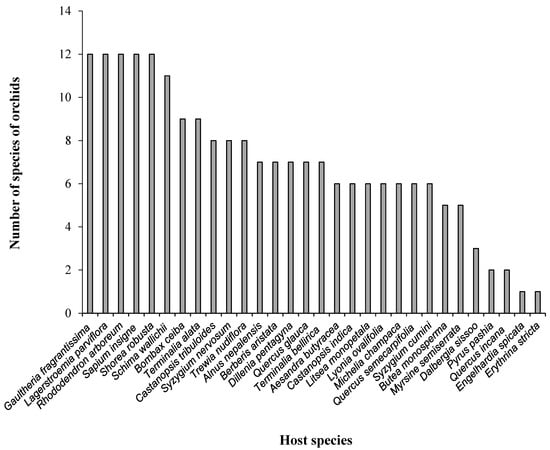
Figure 1
Open AccessReview
Management Strategies of Prosopis juliflora in Eastern Africa: What Works Where?
by
Hellen Wangechi Kamiri, Simon K. Choge and Mathias Becker
Diversity 2024, 16(4), 251; https://doi.org/10.3390/d16040251 - 22 Apr 2024
Abstract
Prosopis juliflora is a shrub/tree originating from the Americas. Since its introduction for fuel wood afforestation into eastern Africa, it has been invading crop- and rangelands with negative effects on the environment and on livelihoods. Understanding the management strategies for Prosopis and matching
[...] Read more.
Prosopis juliflora is a shrub/tree originating from the Americas. Since its introduction for fuel wood afforestation into eastern Africa, it has been invading crop- and rangelands with negative effects on the environment and on livelihoods. Understanding the management strategies for Prosopis and matching them with ecological, social-cultural, and economic needs of the eastern African region is a pressing scientific issue. We analyzed management strategies of Prosopis, focusing on determinants and drivers of their choice of applied management strategies as well as their effectiveness. We identified 1917 scientific contributions published between 1970 and 2022. Following a multi-step screening, we reduced the references to 53 relevant (internationally) published papers with a focus on the management of Prosopis in the east African region. Analysis of the literature shows that factors driving invasion dynamics but also land users’ social-economic as well as cultural attributes determine the type of management strategy and shape local control actions. Main strategies comprise (1) physical containment of invasive spread, (2) chemical, mechanical and biological approaches to reduce stand densities, (3) complete eradication, (4) restoration of invaded land, and (5) economic use of Prosopis products. Adopted strategies are based on actual and perceived impacts of invasion, and the adoption and success of individual strategies is highly location specific.
Full article
(This article belongs to the Special Issue Ecology and Evolution of Invasive Plant Species)
►▼
Show Figures
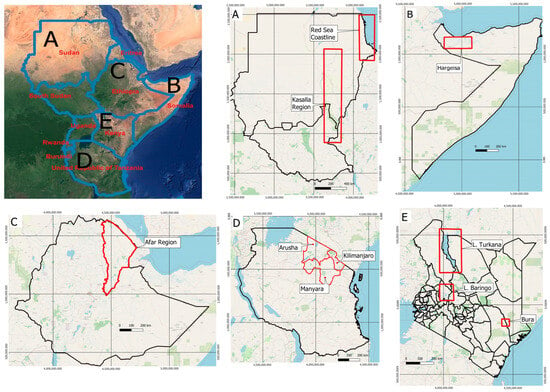
Figure 1
Open AccessArticle
Types and Fecundity of Neotenic Reproductives Produced in 5-Year-Old Orphaned Colonies of the Drywood Termite, Cryptotermes domesticus (Blattodea: Kalotermitidae)
by
Wenjing Wu, Zhenyou Huang, Shijun Zhang, Zhiqiang Li, Bingrong Liu, Wenhui Zeng and Chuanguo Xia
Diversity 2024, 16(4), 250; https://doi.org/10.3390/d16040250 - 22 Apr 2024
Abstract
Orphaned colonies of Cryptotermes domesticus readily produce replacement reproductives and continue propagation. In this study, we aimed to investigate the production and fecundity of neotenic reproductives in 5-year-old colonies of C. domesticus after orphaning. All 15 experimental colonies were successfully re-established by the
[...] Read more.
Orphaned colonies of Cryptotermes domesticus readily produce replacement reproductives and continue propagation. In this study, we aimed to investigate the production and fecundity of neotenic reproductives in 5-year-old colonies of C. domesticus after orphaning. All 15 experimental colonies were successfully re-established by the neotenic reproductive pair. Three types of neotenic reproductives with various wing-bud lengths were observed: type I with micro wing buds, type II with short wing buds, and type III with long wing buds. Four patterns of pairs made up of these neotenics, namely, type I + type II, type I + type III, type II + type II, and type II + type III, exhibited reproductive capacities similar to those of the primary reproductive pair. We speculated that these neotenic reproductives were derived from various nymphal instars. The 5-year-old colonies had three instars of nymphs, with the majority being in the second instar, followed by the first. Thus, the combination of neotenic reproductives with short wing buds and micro wing buds was the dominant differentiation pathway of the orphaned colonies. After the removal of the original primary reproductive pair, the nymphs matured into neotenic reproductives and took over reproduction in the colony in 107.40 ± 15.18 days. This study highlights the importance of quarantine and routine inspection of wood, as well as the significance of early prevention and control of C. domesticus infestation in wood. Moreover, this study confirms the high differentiation and reproductive capacities of C. domesticus.
Full article
(This article belongs to the Special Issue Diversity and Ecology of Termites)
►▼
Show Figures
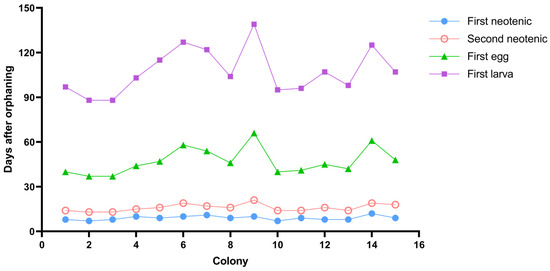
Figure 1
Open AccessArticle
Soil-Microbial CNP Content and Ecological Stoichiometry Characteristics of Typical Broad-Leaved Tree Communities in Fanjing Mountain in Spring
by
Wenmin Luo, Xianliang Wu, Sheng Chen, Guiting Mu and Yingying Liu
Diversity 2024, 16(4), 249; https://doi.org/10.3390/d16040249 - 22 Apr 2024
Abstract
►▼
Show Figures
This study aims to investigate the impact of diverse forest stand types and soil depths on soil ecological stoichiometry characteristics, shedding light on nutrient limitations and cycling patterns within the mid-subtropical forest ecosystem in southwest China during spring. The research focused on four
[...] Read more.
This study aims to investigate the impact of diverse forest stand types and soil depths on soil ecological stoichiometry characteristics, shedding light on nutrient limitations and cycling patterns within the mid-subtropical forest ecosystem in southwest China during spring. The research focused on four representative forest stands situated in Fanjing Mountain: Castanopsis fargesii (C. fargesii), Cyclobalanopsis multiervis (C. multiervis), Cyclobalanopsis argyrotricha (C. argyrotricha), and Rhododendron argyrophyllum Franch (R. argyrophyllum). Sample plots were established in these forest types, and soil samples were collected from the 0–20 cm and 20–40 cm soil layers in March, spring of 2023. Various soil parameters, including pH, soil organic carbon (SOC), total nitrogen (TN), total phosphorus (TP), soil microbial biomass carbon (MBC), soil microbial nitrogen (MBN), and soil microbial phosphorus (MBP) were measured, and their stoichiometric ratios were calculated. The findings of the study were as follows: (1) In the 0–20 cm soil layer, C. argyrotricha exhibited the highest soil organic carbon, followed by C. fargesii, C. multiervis, and R. argyrophyllum with the lowest content. No significant differences in soil organic carbon were observed among the four forests in the 20–40 cm soil layer. Additionally, C. argyrotricha displayed a significantly higher soil C:N ratio compared to other forest types in different soil layers. In the typical broad-leaved forest area of Fanjing Mountain, the TP was classified as deficient. (2) In the 0–20 cm soil layer, the MBC of C. fargesii surpassed C. multiervis, C. argyrotricha, and R. argyrophyllum by 26.59%, 42.92%, and 24.67%, respectively. There were no significant differences in soil MBC:MBP ratio and MBN:MBP ratio, regardless of forest species and soil depths. The low availability of soil nitrogen in different forest stand types in Fanjing Mountain strongly limits soil microorganism biomass. (3) The correlation between SOC, TN, TP, and their stoichiometric ratios varied across different soil layers. Therefore, in managing the Fanjing Mountain forest area, attention should be paid to supplementing N and P in the soil.
Full article
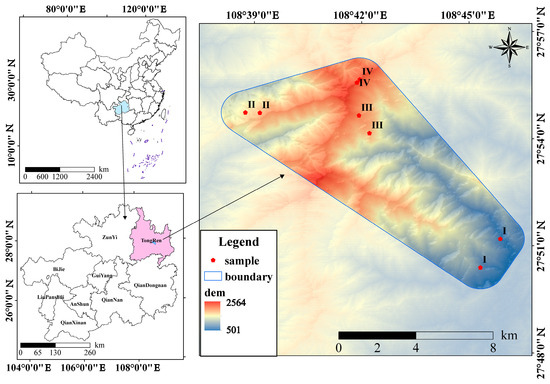
Figure 1
Open AccessArticle
Phylogenetic Trends in the Dissymmetrisation of Genitalia in Hadenini (Lepidoptera, Noctuidae)
by
Zoltán Varga, Gábor Ronkay and László Ronkay
Diversity 2024, 16(4), 248; https://doi.org/10.3390/d16040248 - 22 Apr 2024
Abstract
The external genital appendages of Noctuidae represent correlated–coevolved elements of a complex structure. The pathways of changes are delimited by some constraints, and they are parallelly evolved in different phyletic lines. Asymmetrical male external genitalia were found in Hadenini, in Polia and its
[...] Read more.
The external genital appendages of Noctuidae represent correlated–coevolved elements of a complex structure. The pathways of changes are delimited by some constraints, and they are parallelly evolved in different phyletic lines. Asymmetrical male external genitalia were found in Hadenini, in Polia and its closely related genera, but also in Anarta (s. l.). In Poliina, the asymmetry of the genital capsule is mostly expressed in the Holarctic Polia nebulosa species group, forming the basal split within Polia (s. str.). Higher species diversity, as a consequence of asymmetry connected with the split of functions between the right and left sides, was observed in Polia (s. str.) and in Anarta (s. l.). The highest level of expansivity was observed in the Holarctic Anarta, where some species are migrating and becoming invasive ones, while a bulk of species populates the steppic and mountainous habitats of North America and Central Asia. Parallelly, while some genera/subgenera of the subtribe Poliina are oligotypic and/or consist of strictly localised species, the sensu stricto Polia species with asymmetrical genital capsules are widely distributed. The diversification of the Hadulina phylogenetic line should have been initiated by the Messinian aridisation crisis. The core area of diversification of Poliina was connected with the Sino-Himalayan region, followed by expansion into the Holarctic boreo-nemoral zone.
Full article
(This article belongs to the Special Issue Speciation, Phylogenetics and Taxonomy of Lepidoptera)
►▼
Show Figures

Figure 1
Open AccessArticle
Exploring the Influence of Soil Salinity on Microbiota Dynamics in Vitis vinifera cv. “Glera”: Insights into the Rhizosphere, Carposphere, and Yield Outcomes
by
Andrea Colautti, Giovanni Mian, Diego Tomasi, Luke Bell and Patrick Marcuzzo
Diversity 2024, 16(4), 247; https://doi.org/10.3390/d16040247 - 20 Apr 2024
Abstract
In a world grappling with the severe effects induced by climate change, one of the most significant concerns affecting agriculture is the gradual decline in water quality for irrigation associated with reduced rainfalls and the consequent increase in soil salinity. This issue is
[...] Read more.
In a world grappling with the severe effects induced by climate change, one of the most significant concerns affecting agriculture is the gradual decline in water quality for irrigation associated with reduced rainfalls and the consequent increase in soil salinity. This issue is particularly crucial for grapevine cultivation (Vitis vinifera L.) and the associated winemaking industry. The aroma of the resulting wines and the yield parameters can be influenced both directly by water quality and indirectly due to the effects exerted by salinity on the microbiota, which directly impacts plant health. To gain insights into this topic, our study aimed to analyse the changes induced in the microbiota of both the rhizosphere and the carposphere due to salt stress using a metabarcoding approach, focusing on Vitis vinifera cv. Glera. The control plants were irrigated with rainwater, while the treated plants were irrigated with water containing salt (NaCl). Our findings revealed significant differences in the microbiota (both fungi and bacteria) of the rhizosphere and carposphere between the two treatments. For instance, the Shannon diversity index (i.e., alpha diversity) was lower in the treated plants compared to the control not-treated ones, whilst the beta diversity did not show any differences. Several microbial phyla exhibited better resilience to this abiotic stress (e.g., Ascomycota, Saccharomycetes, Acidobacteria, Proteobacteria, Bacteroidetes), shedding light on their impact on crucial bacterial and fungal groups essential for the subsequent winemaking stages. Additionally, the salt stress negatively affected the yield parameters. This study contributes valuable insights to the viticultural community, providing a deeper understanding of the complex interplay between soil characteristics, microbial communities, and their influence on productivity.
Full article
(This article belongs to the Section Microbial Diversity and Culture Collections)
►▼
Show Figures
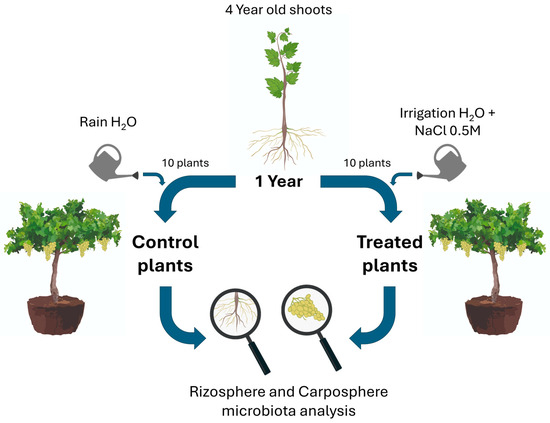
Figure 1
Open AccessArticle
Ascochyta erotica sp. nov. Pathogenic on Convolvulus arvensis
by
Maria Gomzhina and Elena Gasich
Diversity 2024, 16(4), 246; https://doi.org/10.3390/d16040246 - 20 Apr 2024
Abstract
►▼
Show Figures
Convolvulus arvensis is an herbaceous dicotyledonous plant in the Convolvulaceae family that is native to Europe and Asia. It is a perennial soboliferous plant and is one of the most harmful weeds. This weed is successful in many types of climates, including temperate,
[...] Read more.
Convolvulus arvensis is an herbaceous dicotyledonous plant in the Convolvulaceae family that is native to Europe and Asia. It is a perennial soboliferous plant and is one of the most harmful weeds. This weed is successful in many types of climates, including temperate, tropical, and Mediterranean climates, but it is most troublesome for agriculture throughout the temperate zone. In this study, several pathogenic isolates were collected from this host. The internal transcribed spacer (ITS) and large subunit (28S) or ribosomal DNA, partial DNA-directed RNA polymerase II subunit (rpb2), and β-tubulin (tub2) genes were amplified and sequenced for all the isolates studied. Further, both a multilocus phylogenetic analysis of DNA sequences and an analysis of morphological features were implemented. Based on the results obtained, all the studied isolates were found to be distinct from any described species in the genus Ascochyta and are, therefore, described here as a new species Ascochyta erotica sp. nov. The pathogenicity of A. erotica sp. nov. was also tested and confirmed on leaf segments of C. arvensis.
Full article
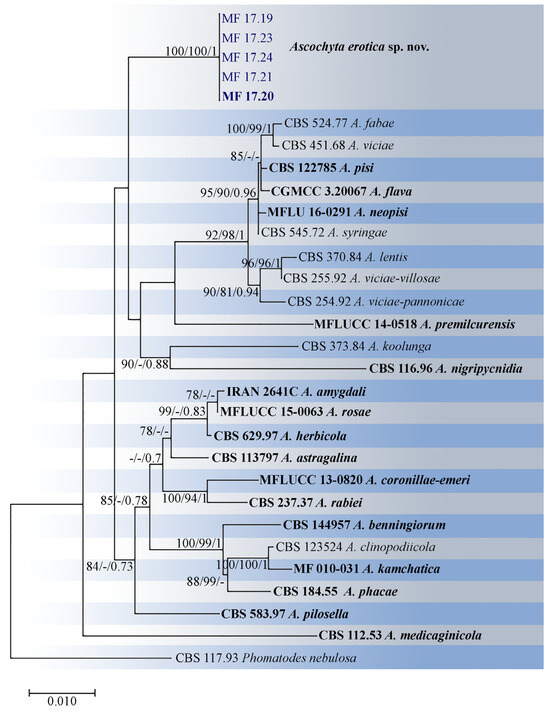
Figure 1
Open AccessArticle
Comparative Metagenomic Analysis of Marine eDNA Investigating the Production Crisis of Aquacultured Saccharina japonica
by
Soyun Choi, Kwon Mo Yang, Dong Mun Choi, Yang Ho Choi, Xiuliang Wang, Lingxiu Wang, Xiaoyong Liu, Delin Duan, Hyun Park and Jeong Ha Kim
Diversity 2024, 16(4), 245; https://doi.org/10.3390/d16040245 - 19 Apr 2024
Abstract
Aquaculture farms cultivating Saccharina japonica are highly active in Wando, Korea, and Rongcheng, China. However, the yield of S. japonica significantly declined in the Rongcheng region in 2022 compared to previous records, whereas that in Wando remained at a normal level, presumably due
[...] Read more.
Aquaculture farms cultivating Saccharina japonica are highly active in Wando, Korea, and Rongcheng, China. However, the yield of S. japonica significantly declined in the Rongcheng region in 2022 compared to previous records, whereas that in Wando remained at a normal level, presumably due to the presence of a pathogenic microbiome. We used environmental DNA (eDNA) metagenomic analysis to compare the microbial compositions of seawater from aquaculture farms in Wando and Rongcheng. Seawater samples were collected from one Korean site in Wando (WA) and two Chinese sites in Ailian Bay (AB) and Lidao Bay (LB). Metagenomic analysis focusing on the microbial 16S rRNA identified 38 phyla and 58 families of microbiomes in all regions. Potentially pathogenic bacterial groups associated with S. japonica in AB and LB were more abundant than in WA, suggesting their potential influence on mortality and the decline in the harvest yield of S. japonica. The microbial composition of WA was distinguished from those of the other two sites, which clustered together with higher similarity. Since the S. japonica aquaculture industry is important for both countries, this comparative eDNA monitoring is a valuable initiation towards the next step of problem-solving practices in coastal management in these two aquaculture systems.
Full article
(This article belongs to the Special Issue Microbial Diversity in Aquatic Systems)
►▼
Show Figures
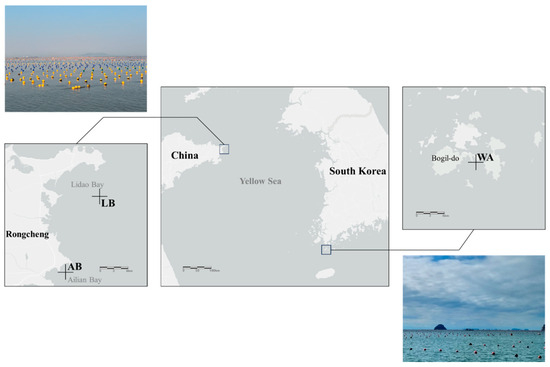
Figure 1
Open AccessArticle
Ecological Impacts of Introduced European Rabbits (Oryctolagus cuniculus) on Island Ecosystems in the Mediterranean
by
Angelina Kossoff, Sheila Schueller, Hannah Nossan, Ian Slack, Pavlos Avramidis and Johannes Foufopoulos
Diversity 2024, 16(4), 244; https://doi.org/10.3390/d16040244 - 19 Apr 2024
Abstract
The Cyclades Islands (Aegean Sea, Greece) are part of the Mediterranean Basin biodiversity hotspot and harbor a plethora of endemic species. Plant communities on the smaller islands in this region have largely evolved in the absence of herbivory and frequently lack antiherbivore defenses.
[...] Read more.
The Cyclades Islands (Aegean Sea, Greece) are part of the Mediterranean Basin biodiversity hotspot and harbor a plethora of endemic species. Plant communities on the smaller islands in this region have largely evolved in the absence of herbivory and frequently lack antiherbivore defenses. This study evaluates the short- and long-term effects of the European rabbit (Oryctolagus cuniculus), an herbivore that has been released on numerous islands in the region, by comparing islands that 1. have historically been rabbit-free (ungrazed); 2. are currently grazed by rabbits, and 3. have previously been grazed, but are now rabbit-free. Ecological impacts of rabbits on the Aegean Islands were investigated by assessing the abundance, composition, and diversity of plant and arthropod communities as well as soil characteristics. Our results indicate that ungrazed islands have more arthropod species, more specialized or endemic plant species, and less exposed soil than currently grazed islands. While ungrazed islands did not necessarily possess higher total plant species richness, they did harbor significantly more small-island endemic taxa relative to presently grazed islands. This study indicates that native plant communities on Mediterranean islets are not adapted to the presence of this introduced species and that the practice of intentionally releasing rabbits on islands has significant and lasting negative ecological impacts, especially on small islands. While a complete recovery of post-rabbit was not evident over the time span of our research, both arthropod and plant data indicate that partial recovery is possible once rabbits have been removed.
Full article
(This article belongs to the Special Issue Recent Advances in the Impacts of Biological Invasions on European Biodiversity)
►▼
Show Figures
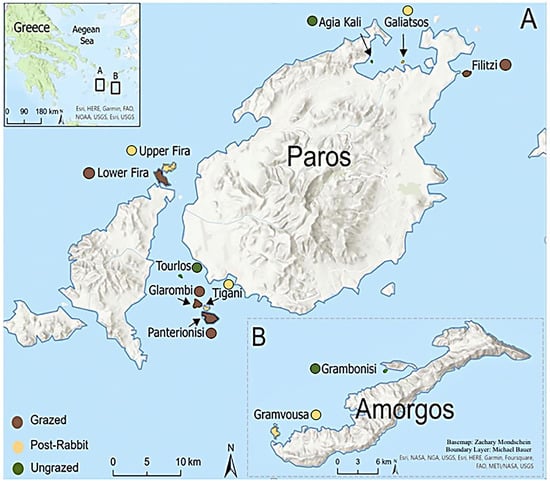
Figure 1
Open AccessArticle
Taxonomic Insights into Caulerpa (Bryopsidales, Chlorophyta) Species in French Polynesia: Confirmation of 13 Species and Reinstatement of C. pickeringii Harvey & Bailey
by
Laura Lagourgue, Thomas Sauvage, Mayalen Zubia, Stefano G. A. Draisma, Christophe Vieira, Aschwin Engelen and Claude E. Payri
Diversity 2024, 16(4), 243; https://doi.org/10.3390/d16040243 - 18 Apr 2024
Abstract
Caulerpa J.V. Lamouroux is a genus of green macroalgae belonging to the family Caulerpaceae in the order Bryopsidales. The genus comprises 104 currently accepted species, of which 51 have been recorded from Pacific Islands. Among these islands, French Polynesia is found in the
[...] Read more.
Caulerpa J.V. Lamouroux is a genus of green macroalgae belonging to the family Caulerpaceae in the order Bryopsidales. The genus comprises 104 currently accepted species, of which 51 have been recorded from Pacific Islands. Among these islands, French Polynesia is found in the middle of the South Pacific Ocean and includes five archipelagos (i.e., the Austral, Gambier, Marquesas, Society, and Tuamotu Islands) where seaweed inventories have reported a total of 16 Caulerpa species so far based on morphology. Here, based on a sampling covering the five archipelagos of French Polynesia, we attempt to (i) verify the taxonomy of Caulerpa species present in these regions based on phylogeny, (ii) describe in more detail the specific diversity between the five archipelagos, and (iii) provide a morphological identification tool for these species. We successfully obtained 134 new tufA sequences for phylogenetic analyses, which corresponded to 13 species. We propose to resurrect C. pickeringii Harvey & Bailey for representatives of C. webbiana var. pickeringii and classify it in the Caulerpa subgenus Araucarioideae. We also transfer C. seuratii to C. pickeringii based on genetic results. A new morphological identification key is provided as well as an updated distribution of Caulerpa species across French Polynesia.
Full article
(This article belongs to the Special Issue Diversity in 2024)
►▼
Show Figures
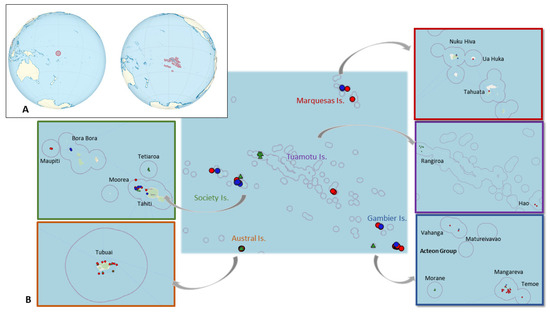
Figure 1

Journal Menu
► ▼ Journal Menu-
- Diversity Home
- Aims & Scope
- Editorial Board
- Reviewer Board
- Topical Advisory Panel
- Instructions for Authors
- Special Issues
- Topics
- Sections & Collections
- Article Processing Charge
- Indexing & Archiving
- Editor’s Choice Articles
- Most Cited & Viewed
- Journal Statistics
- Journal History
- Journal Awards
- Conferences
- Editorial Office
Journal Browser
► ▼ Journal BrowserHighly Accessed Articles
Latest Books
E-Mail Alert
News
Topics
Topic in
Conservation, Diversity, Forests, Land, Remote Sensing
Environmental Monitoring and Environmental Restoration for the Arid Lands and Wetlands
Topic Editors: Xinxin Wang, Yongchao Liu, Jie Wang, Xiaocui WuDeadline: 30 April 2024
Topic in
Diversity, Geosciences, Land, Resources, Sustainability
Advances in Geodiversity Research
Topic Editors: Paulo Pereira, Murray Gray, Maria da Glória GarciaDeadline: 20 May 2024
Topic in
Diversity, Environments, JMSE, Toxics, Water
Coastal Macro-, Meso-, and Microplastic Pollution: Effects on the Health of Humans and Ecosystems
Topic Editors: Alba Ardura Gutiérrez, Sara Fernandez FernandezDeadline: 30 May 2024
Topic in
Agronomy, Diversity, Forests, IJPB, Plants
Plant Invasion
Topic Editors: Bruce Osborne, Panayiotis G. DimitrakopoulosDeadline: 31 July 2024

Conferences
Special Issues
Special Issue in
Diversity
Spatial and Temporal Studies in Marine Protected Areas: Mexican Chapter
Guest Editor: Marlenne Manzano-SarabiaDeadline: 30 April 2024
Special Issue in
Diversity
Microbial Diversity in Aquatic Systems
Guest Editors: Ana C. Sampaio, Patricia Poeta, Florin AonofrieseiDeadline: 15 May 2024
Special Issue in
Diversity
Mangrove Regeneration and Restoration
Guest Editor: Thomas FickertDeadline: 30 May 2024
Special Issue in
Diversity
Ecology and Conservation of Marine Megafauna
Guest Editor: José Carlos BáezDeadline: 20 June 2024
Topical Collections
Topical Collection in
Diversity
Feature Papers in Biogeography and Macroecology
Collection Editor: Michel Baguette
Topical Collection in
Diversity
Feature Papers in Phylogeny and Evolution
Collection Editor: Eric Buffetaut
Topical Collection in
Diversity
Collection of Experts’ Researches on Aquatic Life (CEREAL)
Collection Editors: Wonchoel Lee, Bum Soo Park, Jae-Ho Jung
Topical Collection in
Diversity
Marine Invasive Species
Collection Editors: Bert W. Hoeksema, Adriaan Gittenberger


